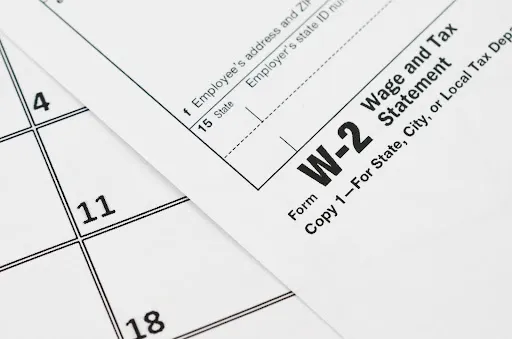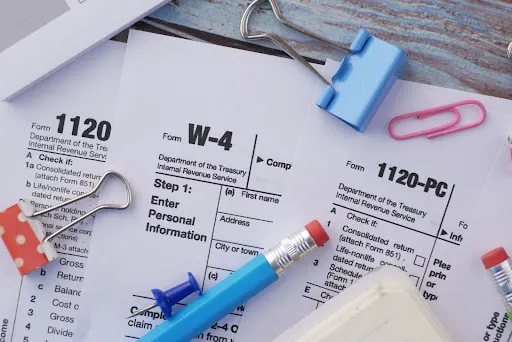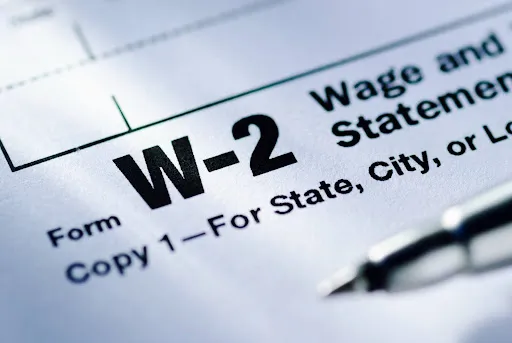
W-4 vs W-2: What's the Difference?
Tax forms often leave employees confused about their responsibilities. The W-4 and W-2 forms, in particular, are crucial for managing taxes correctly. Failing to understand them can lead to errors, delays, and unnecessary stress during tax season. Knowing how they work helps both employees and employers maintain compliance. It also ensures smooth payroll and tax filing processes.
Understanding W-4 and W-2 Forms
Navigating tax forms begins with understanding their purpose. W-4 and W-2 forms are often confused with one another, but they serve very different functions. Their unique roles directly affect how taxes are calculated and reported.
What is a W-4 Form?
The W-4 form determines how much tax is withheld from your paycheck. Employees fill it out when starting a new job or experiencing life changes. This form includes information about marital status, dependents, and other tax-related factors. Employers rely on the W-4 to calculate deductions for federal income taxes. Adjusting your W-4 ensures your tax withholding aligns with your financial situation.
What is a W-2 Form?
The W-2 form summarizes your annual earnings and taxes withheld. Employers issue it at the start of each year to employees who earned wages during the previous year. It details income, Social Security contributions, and federal and state taxes withheld. Employees use the W-2 to file their tax returns and report income to the IRS. Accurate W-2s are essential for filing correct tax returns and avoiding penalties.
Key Differences Between W-4 and W-2
Although they may seem similar, the W-4 and W-2 forms serve different purposes. Each plays a distinct role in the tax and payroll process. Recognizing these differences helps avoid confusion during tax preparation.
Purpose of Each Form
The W-4 helps adjust payroll tax withholding based on your circumstances. It’s completed by employees to guide employers on how much tax to deduct. The W-2, on the other hand, is a summary of the income and taxes withheld for the year. Employees use it to prepare and file their tax returns. These two forms, though related, are not interchangeable.
When and How They Are Used
Employees fill out the W-4 during job onboarding or after significant financial changes. Employers issue the W-2 at the end of the tax year for reporting purposes. While the W-4 affects ongoing payroll, the W-2 is a snapshot of the year’s earnings. Both require accuracy to ensure tax compliance and avoid penalties. Their different timing and roles highlight their unique functions.
How to Read and Interpret W-4 and W-2 Forms
Tax forms often feel overwhelming, but understanding their components simplifies the process. Breaking down each form helps employees and employers avoid mistakes. Familiarity with key sections ensures accurate information is provided and reduces confusion during tax filing.
Key Sections of the W-4 Form
The W-4 includes fields for personal details like name, address, and Social Security number. It asks for marital status, which affects tax withholding. Additional sections allow employees to claim dependents and list other income or deductions. The form may also include adjustments for multiple jobs. Reviewing these details ensures your withholding reflects your actual tax liability.
Key Sections of the W-2 Form
The W-2 reports wages in Box 1, federal income tax withheld in Box 2, and Social Security wages and tax in Boxes 3 and 4. State-specific information is listed in separate sections detailing state wages and taxes. Other boxes report benefits, tips, and retirement contributions. Checking each section ensures your tax filings are accurate. Misreporting any detail can lead to IRS issues.

Common Mistakes With W-4 and W-2 Forms
Errors on tax forms can cause unnecessary stress and financial headaches. Many employees and employers overlook details that can lead to complications. Identifying common mistakes helps avoid these pitfalls.
Errors With the W-4 Form
Filling out the W-4 incorrectly can lead to inaccurate tax withholding. Forgetting to update it after life events, like marriage or a new dependent, causes mismatched deductions. Overestimating allowances might result in a large tax bill later. Underestimating them can leave you with less take-home pay than expected. Reviewing and revising your W-4 ensures it reflects your current financial situation.
Mistakes With the W-2 Form
Errors on the W-2 can delay tax filing or trigger IRS audits. Incorrect Social Security numbers or mismatched income figures create problems. Employees must review their W-2 for accuracy before submitting their tax returns. Employers also need to ensure that all data matches payroll records. Addressing errors early prevents more significant issues during tax filing season.
State-Specific Variations of W-4 and W-2 Requirements
Tax requirements often vary by state, adding another layer of complexity. Many states have versions of the W-4 and additional rules for W-2 forms. These variations can impact how taxes are withheld and reported for employees.
State-Specific W-4 Forms
Several states, such as California and New York, require employees to complete a state-specific W-4 form. These forms account for unique state income tax rates, deductions, and credits. Employees in multiple states may need to fill out separate forms for each location. Failing to comply with these requirements can result in incorrect withholding or penalties. Reviewing state-specific instructions ensures proper adjustments.
Additional W-2 Reporting Requirements
Some states require additional reporting on W-2 forms, such as local taxes or specific benefit contributions. States like Pennsylvania include local income tax withholdings in the W-2. Employers must comply with these rules to avoid discrepancies during state tax filings. Employees should verify that all relevant taxes are reflected on their W-2. Keeping records of state-specific deductions aids in accurate tax preparation.
How States Handle Dual Residency
Tax rules can be incredibly challenging for individuals living and working in different states. Some states have reciprocal agreements that simplify withholding requirements, while others require filing taxes in both the work and residence states. Employers must understand these agreements to issue the correct W-4s and W-2s. Employees benefit from consulting a tax professional to navigate dual residency complexities.
Resources for Navigating State Rules
Many state tax agencies provide resources and online tools to assist employers and employees. These platforms often include guidelines for filling out state W-4 forms and managing W-2 reporting. Staying informed about state-specific tax regulations reduces errors and ensures compliance. Both employers and employees should take advantage of these resources for seamless tax management.
W-4 and W-2 Forms in Special Circumstances
Tax forms aren’t one-size-fits-all; unique situations often require special considerations. Addressing these cases ensures compliance and reduces confusion. Understanding how these forms apply in unique scenarios helps avoid errors and provides accurate tax filings.
Handling Multiple Jobs
If you work multiple jobs, each employer requires a W-4. Use the IRS online estimator to calculate proper withholding. Failing to adjust for various employment can result in underpaid taxes. Include income from all jobs to ensure accurate filing. Regularly reviewing your W-4 helps avoid surprises during tax season.
Filing Taxes for Minors or Dependents
W-2 forms may be issued to minors working part-time jobs. They must report earned income, even if their parents claim them as dependents. Parents should review the minor’s W-4 to ensure proper withholding. Missteps in handling minors’ tax forms can lead to errors. Professional advice can help navigate these unique scenarios.

How to Avoid W-4 and W-2 Mistakes
Proactive management can avoid tax-related mistakes. Both employees and employers have responsibilities to ensure accuracy. Following best practices keeps tax processes smooth.
Suggestions for Employees
Always double-check W-4 entries before submitting them to your employer. Update the form when your financial or personal situation changes. For the W-2, compare its details with your payroll records for consistency. Report discrepancies to your employer immediately. If taxes feel overwhelming, consult a professional for guidance.
Recommendations for Employers
Educate employees about completing the W-4 form correctly. Use reliable payroll systems to ensure accurate calculations. Verify W-2 details carefully before issuing them to employees. Stay updated on tax regulations that may affect these forms. Providing clear communication and resources fosters compliance.
How Employers Can Streamline W-4 and W-2 Management
Efficient handling of these forms reduces errors and improves compliance. Employers have tools and strategies to make the process seamless. Clear communication and regular updates on tax regulations further support accurate and timely management.
Leveraging Digital Solutions
Payroll software simplifies tax form management for employers. It automatically calculates withholding and generates accurate W-2 forms. Tools like ADP and Gusto reduce manual errors. Digital systems also allow for electronic submission, saving time. Employers benefit from investing in these tools to maintain compliance.
Providing Employee Training
Employers should educate staff about filling out the W-4 correctly. Providing clear instructions reduces employee errors and avoids payroll confusion. Workshops or guides can help employees understand their W-2s better. Training builds a culture of accuracy and compliance in the workplace.
The Role of W-4 and W-2 Forms in Tax Audits
Accurate handling of these forms is essential in avoiding audits. These documents are often reviewed during IRS investigations to verify compliance. Ensuring consistency between these forms and payroll records can prevent red flags and unnecessary scrutiny from tax authorities.
W-4s in Audits
The IRS examines W-4 forms to ensure proper tax withholding. Mismatches between claimed allowances and reported income can trigger scrutiny. Employers should retain accurate records of employee W-4s. Ensuring these forms align with pay records helps prevent audit complications.
W-2s in Audits
The W-2 serves as a key document during tax audits. Inconsistent earnings or unreported income often raise red flags. Employers must ensure that W-2s match their payroll records. Employees should double-check their W-2s for accuracy before filing. Clear documentation minimizes the risk of penalties or further investigation.
